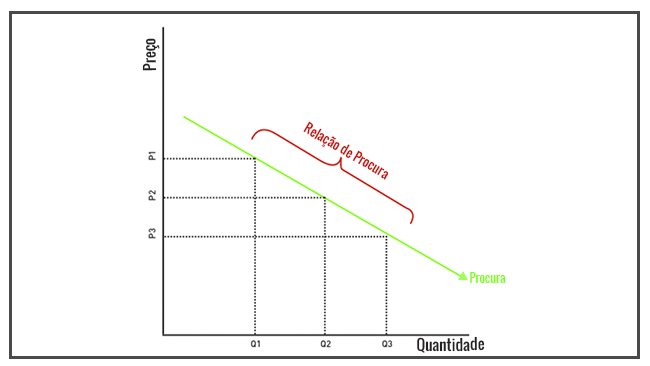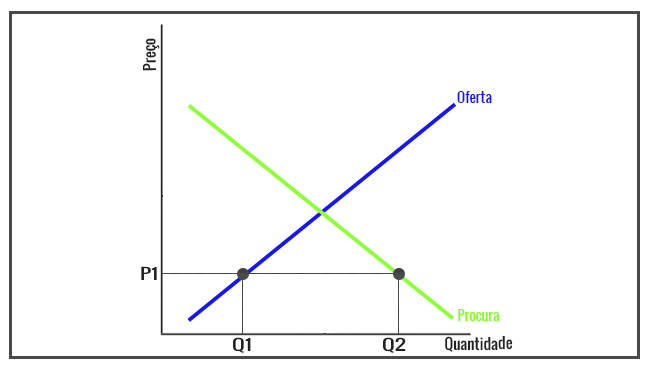The law of supply and demand is one of the bases of the market and consists of the relationship between the price of goods and services offered and the existing demand for them.
The law of supply and demand is one of the most important concepts in economics as it works as a pricing model and determines the best way to allocate resources. Due to this regulatory function, the law of supply and demand is the very essence of economic liberalism, which defends an independent and self-regulated market.
Demand concerns how much a product or service is desired by buyers willing to pay a certain price. The analysis between price and quantity demanded by buyers results in the call law of demand.
The offer refers to how much of a product or service the market can make available for a given price. The correlation between the price and how much of a good or service is offered by the market is known as supply law.
The law of supply and demand is nothing more than the combination of the law of demand and the law of supply. The concept analyzes the interaction between the two relationships and is used in the definition of prices for goods and services. Furthermore, the law explores the different results in cases of balance and imbalance of relationships.
How does the law of demand work?
The law of demand states that, in a scenario of perfect competition, the higher the price of a good or service, the lower the demand for it. As the price decreases, the greater will be the demand. The diagram below demonstrates the relationship:

Graphic representation of the so-called demand curve or demand curve.
At price “P1”, the quantity demanded is “Q1”. When the price of the good or product is increased to “P2”, the quantity demanded is decreased to “Q2”, and so on. Assuming all other factors remain the same, the quantity demanded varies inversely with the price.
Example 1: As Children's Day approaches, stores tend to increase the price of toys. This makes many consumers give up on purchasing this type of good and look for other alternatives, such as clothing, electronics, etc.
Example 2: After Easter, several stores keep surplus products such as eggs and chocolate boxes. To sell products faster, stores lower prices, resulting in increased demand from consumers.
How does the law of supply work?
The law of supply is the exact opposite of the law of demand. The law provides that, as the prices of goods and services increase, suppliers tend to offer increasingly, as selling more and at a higher price significantly increases profits. Check out the diagram below:

The graph above represents the so-called "supply curve".
When the price “P1” rises to “P2”, the quantity supplied in the market increases to “Q2”, and so on. Thus, if all factors remain the same, the quantity offered varies in proportion to the price.
Example: Knowing that the piped water supply has been interrupted in the region, the city's mineral water suppliers increase the price of the product. Given that demand does not decrease (considering the essential nature of the product), suppliers continue to produce more goods and, as far as possible, increase the price.
law of supply and demand
When supply and demand relations are analyzed together, the two work in mirror, as shown in the diagram:

At a given price “P” the quantity demanded and the quantity supplied intersect, forming an equilibrium point. In it, suppliers sell all the goods and products offered and consumers receive everything they are looking for.
The balance point between supply and demand relations is the ideal economic scenario in which consumers and producers are satisfied.
know more about supply and demand and invisible hand.
Imbalance in supply and demand relations
Whenever the price of a good or service is not equal to the quantity demanded, there will be an imbalance in the supply and demand relationship. In these cases, the two possible hypotheses are:
oversupply
If the price of a good or service is too high, the market will face an oversupply, meaning that resources are not being allocated effectively.

In cases of oversupply, at a certain price “P1”, the quantity of goods and services that suppliers are willing to offer is indicated by “Q2”. However, at the same price, the quantity of goods and services that consumers want to purchase is “Q1”, ie, less than “Q2”.
The result of the diagram above is that a lot is being produced and little is being consumed. In this scenario, the need to lower prices will arise.
over-demand
Excess demand is created when the set price is below break-even. If the price is low, many consumers will demand the good or service, causing a shortage in the market.

In this situation, at a price “P1”, the quantity of goods and services demanded by consumers is “Q2”, while suppliers are able to produce, for a given price, only “Q1”. Thus, the goods and services produced are insufficient to satisfy consumer demand.
Excessive demand will make consumers compete for the purchase of goods and services, causing producers raise prices, which will occasionally diminish demand and restore the balance of the market. Marketplace.
Who created the law of supply and demand?
The law of supply and demand has no definite authorship. It is known that the notion of law was already known in the 14th century by several Muslim scholars, who understood that if the availability of a good decreased, its price increased.
In 1961, the English philosopher John Locke described in one of his works the concept that today defines the law of supply and demand without, however, using this nomenclature. At the time, the philosopher wrote: "The price of any commodity increases and decreases in proportion to the number of buyers and sellers, and this regulates the price...".
The term "supply and demand" was first used by the Scottish economist James Steuart in 1767 and, years later, by Adam Smith.
See too:
- Economy
- Microeconomics
- economic liberalism
- Liberalism

